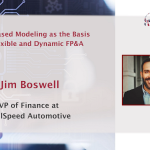This article provides an overview of the topics and cases presented and discussed by the expert...

We continue to live in uncertain times. It poses even more challenges to our usual planning exercises:
- we act under less transparent conditions,
- our environment changes more often, more deeply and faster,
- we are confronted with a larger amount of data than ever before,
- and the conventional control measures we have used for a long time have suddenly become ineffective.
Under such circumstances, planning becomes nearly an impossible task. Yet, this is precisely when we long for a solid plan to weather the storm. The usual answer: we start to plan more, more often, in more detail, and longer term. As a result, the more we try to make sense of our uncertain environment, the more doubtful our results become, thus leading to an infinite planning spiral.
Driver-Based Planning can help us mitigate the current uncertainty.
5 Practical Steps to Implement Driver-Based Planning
While the need for planning (financials, demand, production, and other considerations) is comprehensible, we believe that we should focus our planning efforts on the items that make a real difference to our business and make some assumptions about the others.
In concrete terms, we recommend the following steps:
1. Identify the key performance drivers
The quality of the result will depend mainly on how well we choose our key drivers. Therefore, the fundamental question is: What defines the key performance drivers?
In principle, they must satisfy the following conditions:
- They must be able to affect the company indeed (distinguish between “signal” - meaningful, sensible information impacting your P&L and “noise” - random fluctuations);
- They must be measurable so that we can control and influence them.
If you go along with this definition, you would automatically exclude macroeconomic indicators such as GDP, unemployment and demographics, to name a few, because we cannot control them. Are they important for our business? Of course, they are, but since we cannot do anything about them, we should avoid our illusion of control bias, possibly limiting them to scenario parameters.
As an example of business drivers, we can look at the B2B FMCG – Food industry.
Usually accepted drivers in this industry can be the following:
- Listing of our products,
- Our presence in leaflets,
- Our second placement in a store,
- Media support for our products.
In this case, controllability does not mean that you can set the desired listings. It is subject to negotiation with your clients. Still, you can aim your efforts at achieving a certain level, which would be impossible if you chose a macroeconomic variable, e.g. inflation.
An interesting result of such an activity is that you may find out, especially in more mature industries, that such drivers remain constant over time. In other words, once this exercise is completed, you may not need to repeat it every year. Take again the food industry: ten years ago, you would have probably come up with the same drivers, and even the rapid growth of the online sales channel for food products has not changed much, as the same drivers apply online as on physical markets, just in a different form.
2. Estimate their development and formulate expectations, objectives and investments.
This is a classical financial viability exercise, which helps find the relationship between the development of single drivers and profitability and can also support further analysis. When do marginal benefits equal marginal costs? Which driver delivers the maximum incremental benefit per amount invested?
In general, there are a few points you may want to consider while implementing this type of process. While they are not a must, you may find them helpful when considering this approach for the first time:
3. Start small.
Try the approach on a product, country, or customer rather than a multibillion-dollar business. Use the opportunity to test, evaluate, and fine-tune everything.
4. Involve your organisation.
Different parts of your company may have different views of what is driving your business, and you should give all of them appropriate consideration.
5. Consider running this process parallel to your customary planning.
It is required at least at the beginning to maximise learning with minimum disruption.
After describing a simple implementation of this form of planning, one question remains: What use can we expect from all this?
Benefits of Driver-Based Planning Under The Lens
In our experience, there are several benefits associated with Driver-Based Planning:
It can be used as a plausibility check of assumptions and goals.
Say you have a goal of increasing sales by 10%. Once you have identified what drivers you need to work on to grow, you can ask yourself how much they should change to achieve the assumed growth. Is it feasible with the current organisation? How is the competitive environment/prices/customers evolving so that you can implement the necessary actions? If it does not sound realistic, you should adjust your objectives.
DBP can help you make your goals and plans transparent.
You have defined your drivers, how they need to evolve, the uplift they generate and the costs that go with it. It is clear what brings what, it is clear what you have to check during your planning horizon to make sure you stay on course, and you can prioritise actions and investments and focus accordingly.
It can be the basis for your Management by Objectives and bonus system.
Once you have defined what is relevant for your organisation and what is decisive to achieving your goals, you can break it down to all departments so that the whole organisation pursues the same goals and everybody is aware of their role in the bigger picture. Eventually, you can sustain the concept by setting MbO-relevant goals and paying bonuses accordingly.
You can scale it up (or down).
You can define objectives at all possible levels in your organisation: the whole company, a subsidiary, a product, a customer, a channel, or any combination of the above and possibly consolidate it all.
Conclusions
To conclude, if it is true that “no plan resists the first encounter with the enemy,” it is also true that this was never a good enough reason to stop planning altogether. Instead, it is an invitation to come to terms with the fact that we cannot predict the future, particularly in situations of great uncertainty. In that case, we should concentrate on the few things that matter and be prepared for possible scenarios.
The more prepared we are, the less we need to predict which scenario will come true.
Subscribe to
FP&A Trends Digest

We will regularly update you on the latest trends and developments in FP&A. Take the opportunity to have articles written by finance thought leaders delivered directly to your inbox; watch compelling webinars; connect with like-minded professionals; and become a part of our global community.




